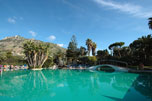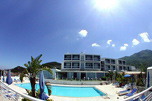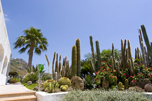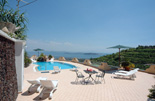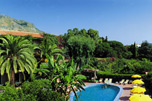Description
The cathedral stands on the top of a hill with the main facade overlooking a small irregular square. The courtyard, paved with lava rock, is enclosed by an iron gate, by Aniello Balsofiore. The facade is flanked by two bell towers culminating in pear. The central section is crowned by a pediment resting on two rows of pilasters. Enliven the prospect of two decorative ceramic tiles colored: the central panel depicts St. Vito in 1881 and the clock tower on the left. The side wall, unlike the main, has not undergone major changes. At the bottom, at the chapels of the aisle, there are three small windows with rounded corners, below the central one is the secondary entrance, in gray stone, similar to that of S. Gaetano. At the top we can see the domes of the chapels above the three windows of the nave slightly arched. Of particular interest and originality is the St. Vito’s dome, supported by a pierced drum by four arched windows and buttressed by scrolls that serve as gutters, according to a typical system Campania. View from above and from the rear, the roof of the church, with its picturesque cupola, the other two domes and massive towers, is reminiscent of a group of Arab mosques (Salvati, 1951). The church is a basilica with three naves, with a square apse and transept. The interior has a nave covered by a barrel vault with lunettes and arches resting on pairs of pilasters, the aisle has three chapels with cupolas at low arch, the junction with the transept is covered with plumes spherical dome, domes low arch covering the apse and arms of the cross, where there are large windows, inside and outside the guitar-shaped with open arched. The interior decoration is sumptuous in stucco of the second half of the eighteenth century, attributed by a certain Francesco Starace. The masonry is in tufa stone.Historical-critical info
S. Vito, the cathedral dedicated to the patron saint of Forio, is the oldest church in the town. D'Ascia (1867) writes: "This church is very old, you have no memory of its founding. [...] The first baptismal records found dates back to 1620." The existence of the church is already documented in 1306 by a bull at the University of Forio confirming the right to have a resident priest in the parish of St. Vito, but the assumptions on the date of foundation of the building are discordant (Algranati: fifteenth century.; Mountains: XII sec. Salvati: 1321; Sardella: XIV sec.). According to the scholar Don Pietro Monti, the church was probably built to replace an older church dedicated to St. Vito built by the inhabitants near the sea Citara, which was organized around the hamlet of Forio. The area was too exposed to the incursions of the Saracens, was later abandoned and the core housing moved into a higher and more secure site, where the new church was erected. The parish of St. Vito in the fourteenth and fifteenth centuries constituted the reference point of the first settlement and played an important role in the local community, the majority of the population had lived at that time on the hill and in the countryside near the church, only to the mid-fifteenth century the village of Forio began to expand towards the sea, around another church, St. Maria di Loreto. In the courtyard of the church, in the sixteenth century, were erected two chapels, one dedicated to St. Martin on the right side, the other dedicated to St. James the Apostle, on the left side, and both were demolished, the first around 1773, the other in 1857, to allow the construction of two towers. Interventions occurred during the eighteenth century that have modified the original Gothic architecture: in 1735 the University of Forio financed an expansion of the complex, built in 1748 and in 1790 the high altar were renovated in stucco, floor and marble altars of the side chapels.According to Salvati (1951) the two bell towers, topped with pears typical of Baroque architecture in southern Italy, date back to the eighteenth-century. D’Ascia informs that it is a tower for the bells, the other for the public clock "newly constructed" and that the tower hosts "the largest bell donated by the Municipality of Ferdinand II in 1854". Reconstruction works of the main facade, the building of the marble pulpit and the erection of new altars, were carried out between 1820 and 1854. The remodeling of the facade, according to Salvati, is a cool implementation of the modules for Vignola, instead of the original, much more rustic and country. The front side has kept its original appearance, and this makes it particularly interesting. In 1881 it was placed a majolica panel depicting St. Vito. A tombstone placed behind the altar reminds the pastor Nicolantonio Maltese who, during the plague of 1656, rather than flee to the country, was to assist the sick, the plague ended, in gratitude, administrators made him pastor of Forio S. Vito. In 1989 the church of S. Vito has been elevated to the Papal Basilica.Inside the basilica there are: the wooden statues of St. Vito of the sixteenth century. Painting of Cesare Calise (1636) with "effigies of St. Gennaro and S. Cecilia, Alfonso Di Spigna a shovel with "S. Vito, S. Catherine of Alexandria and the Lady "(1745), a wooden altarpiece of the fourteenth century represents the "Madonna delle Grazie, S. Catherine d 'Alexandria and St. Vito ", 700 paintings of" Our Lady of the Rosary "and" Madonna delle Grazie, S. And St. Nicholas Rocco ", canvas del Monte with the figures of" St. Joseph, S. Aniello, S. Lucy "(1885), wooden statue of" Immaculate "by sculptor Anthony Marotta (1858), statue of St. beginning 800 Anthony of Padua unknown sculptor.
Painting of "Magdalene" by the painter Domenico Antonio Verde (1710), an altar piece by Alfonso Di Spigna "The Deposition". The toiles of the "Way of the Cross" half of the XVIII century of painted by a good painter of the school of Salvatore de Rosa, semi-circular table by an unknown artist depicting "St. Joseph, who baptized Jesus. "
Info
Address: Via San Vito
City Hall: 80075 - Forio
Period of Foundation: XIV cent.
Date: 1300
Holy Masses hours: sun 9:00, 11:00, 18:00/19:00
Parroco: Canon Giuseppe Regine
Bus lines: 1 - 14 - 2 - CD - CS
Works of art
Paintings
- Battesimo di Cristo unknown author
- Martirio di S. Caterina d'Alessandria unknown author
- Sacra Famiglia con S. Anna e S. Gioacchino dell' autore Manecchia Anna Maria
- Compianto sul Cristo morto attr. all' autore Di Spigna Alfonso
- Visione e martirio di S. Vito unknown author
- Trinità con S. Gennaro e S. Cecilia by Calise Cesare
- Maddalena dell' autore Verde D. A.
- Madonna delle Grazie con S. Caterina d'Alessandria e S. Vito, e lunetta raffigurante La Crocifissione unknown author
- Gloria della Vergine con S. Vito e S. Caterina d'Alessandria by Di Spigna Alfonso
sculptures
- Immacolata autore ignoto
- S. Vito by Sanmartino Giuseppe
squares
- S. Vito unknown author
stuccos
- Parietal decorations unknown author
Near to
Hotel Park Victoria
Porto di Forio
Museo Il Torrione
Torre Torone
Torre di Vico Schiano
Torre di Via Morgera
Il Torrione
Torre Milone
Torre Costantina
Torre Cigliano
Torre Casa Patalano
Torre Corso Umberto
Chiesa di S. Gaetano
Chiesa San Carlo
S. Maria di Loreto
Oratorio della Assunta
Parr. di S. Sebastiano
Cinema delle Vittorie
Rist. Scogli Innamorati
Rist. Pizz. Epomeo
Galleria Eloart
Giocattoleria Cart. R2
Serpico Sapori
La Conchiglia
Pietratorcia Wine Bar
Fiori e Piante La Ninfea
Farm. Dr. Migliaccio


















